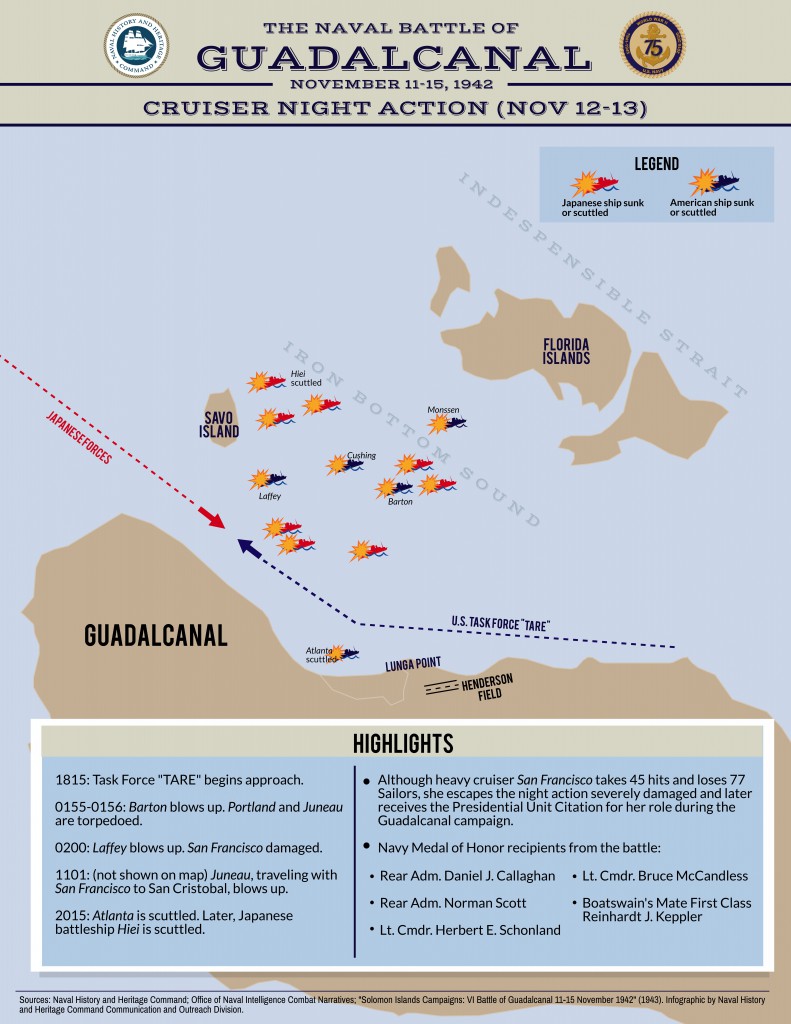WWII Warship Lost with Five Sullivan Brothers Has Been Found
Posted on Categories Discover Magazine
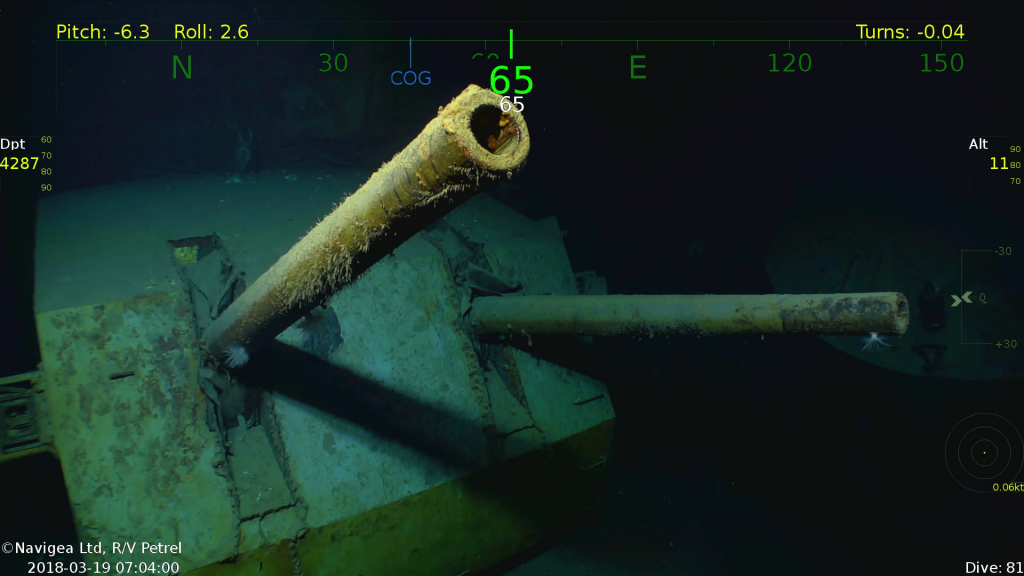
A gun turret containing a Mark 12 5-inch gun from the USS Juneau that was discovered as part of the sunken warship’s wreckage on March 17, 2018. Credit: Navigea Ltd.
One of the most well-known stories of family sacrifice in wartime is the loss of the five Sullivan brothers aboard the light cruiser USS Juneau during World War II. That story resurfaced after an expedition headed by Microsoft co-founder Paul Allen discovered wreckage from the USS Juneau lying on the ocean floor in the South Pacific.
Serving together aboard the USS Juneau, the Sullivan brothers were all lost at sea after their battle-damaged warship received a torpedo hit that blew the Juneau in half and killed most of the crew. Their deaths have played into some myths and misconceptions surrounding U.S. military policies on permitting family members to serve together and excusing “sole survivors” from duty. But their loss also represents just one chapter in a broader story of fighting and dying alongside family members in times of war.
Joining Up and Serving Together
The five Sullivan brothers grew up in the small town of Waterloo, Iowa and bounced around between school and doing odd jobs during the Great Depression of the 1930s. By 1937, the eldest brothers Frank and George had signed up for the U.S. Navy. They were able to both get stationed together on the destroyer USS Hovey as part of four years of peacetime service that ended in May 1941. Such family postings together in the peacetime Navy were supposedly standard practice for the time, according to the Naval History and Heritage Command.
The Imperial Japanese military’s attack on the U.S. naval base at Pearl Harbor, Hawaii on December 7, 1941 provided a personal wakeup call to the Sullivans. Two good family friends—a pair of Iowan brothers named Bill and Masten Ball—were serving on the battleship USS Arizona that sank after being torn apart by a violent explosion from a bomb going off in one of the warship’s powder magazines. Masten survived, but Bill lost his life.
Bill’s death spurred the Sullivan brothers to enlist in the Navy together. George, one of the elder brothers who had formerly served in the Navy, wrote a letter on behalf of all the Sullivans that petitioned the Navy to keep the “five brothers and two buddies” together during deployment. “As a bunch, there is no-body that can beat us,” Frank Sullivan wrote in the letter.
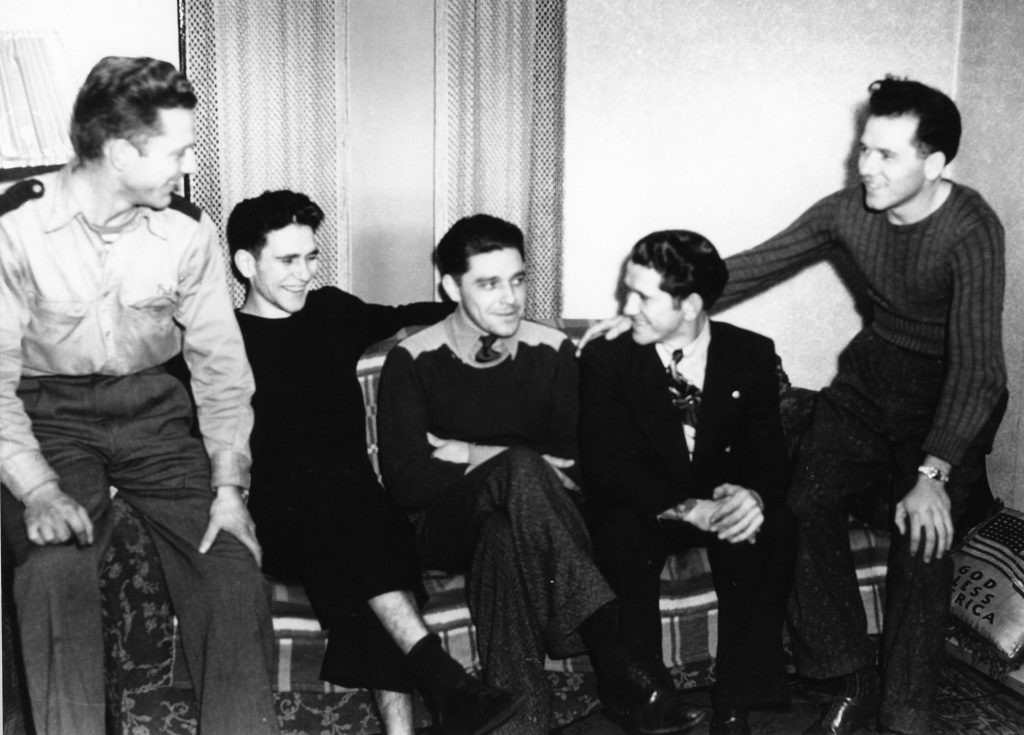
The five Sullivan brothers. From left to right: Joseph, Albert, George, Francis, Madison. Credit: Sullivan Brothers Iowa Veterans Museum.
The Sullivans’ request technically went against the Navy’s official policies of the time period. In July 1942, the Bureau of Naval Personnel’s published an article in its Information Bulletin that forbade commanding officers from forwarding requests such as those from the Sullivan brothers.
The Bureau considers that it is to the individual family interest that brothers not be put on the same ship in war time, as the loss of such a ship may result in the loss of two or more members of the family, which might be avoided if brothers are separated. An instance of this was the loss of three brothers on the USS Arizona at Pearl Harbor, T. H. (Territory of Hawaii), on December 7, 1941. In view of the above, Commanding Officers will not forward requests for brothers to serve in the same ship or station.
But the U.S. Navy did not seem to actually enforce this policy in practice, according to the Naval History and Heritage Command. The Sullivans got their wish to serve together aboard the light cruiser USS Juneau that was commissioned for active duty on Valentine’s Day, 1942.
The Night of Battle
The USS Juneau and the Sullivans became part of the first major Allied offensive against Imperial Japan in the Guadalcanal campaign of the South Pacific. In August 1942, American and Australian naval forces supported U.S. Marines who seized Guadalcanal and other islands in the Solomon Islands chain from the Japanese troops who had occupied them earlier.
But the Imperial Japanese military was not willing to give up on Guadalcanal. Control of the island and its airfield could have potentially allowed Japanese warplanes to threaten sea supply lanes between the United States and Australia. Attempts to land more Japanese troops and reinforcement by Japanese naval forces led to multiple land and naval battles with the Allied forces.
By November 1942, the struggle was still ongoing as both Allied and Japanese forces attempted to reinforce their troops on the island. On November 13, the USS Juneau joined two other light cruisers, two heavy cruisers and eight destroyers as they steamed out to meet an approaching Imperial Japanese naval force that included two battleships, a light cruiser and 11 destroyers.
The resulting night battle became a brutal slugfest in the dark as both sides traded cannon fire and torpedoes at close quarters. During the 40 minutes of chaotic combat, the USS Juneau received a torpedo hit and was forced to retire from battle. The light cruiser rejoined the surviving U.S. ships at dawn and began moving off to the southeast.
A Japanese submarine sighted the U.S. ships around 11 AM and fired a spread of three torpedoes aimed at the damaged heavy cruiser USS San Francisco. None of the torpedoes struck the heavy cruiser, but one traveled beyond and hit the USS Juneau on the port side close to where it had been previously damaged. That second torpedo strike set off a huge explosion in the cruiser’s ammunition storage that blew the ship in half.
An estimated 115 members of the ship’s crew initially survived the explosion, including possibly one or two of the Sullivan brothers. But delays in sending rescue efforts due to fears of additional enemy submarines and ships meant that only 10 men were rescued from the water eight days after the USS Juneau went to the bottom. None of the Sullivans were among the survivors.
Total U.S. losses from the battle included two light cruisers—the USS Juneau being among the casualties—and four destroyers. The Imperial Japanese force lost two destroyers and was forced to scuttle a badly damaged battleship. More importantly, the Japanese naval force retreated and never carried out its mission of bombarding the U.S. airbase on Guadalcanal, which enabled U.S. warplanes to continue operating from there.
Family Service and Sole Survivor Policies
The publicized loss of the Sullivans led to proposals for a Congressional act that would prohibit family members from serving together. But in the end, Congress never took action on that matter, according to the Naval History and Heritage Command. For that matter, no president ever enacted a similar policy through executive order.
Still, the U.S. military did take some steps to recognize family sacrifices and potentially alleviate the pain of a family losing all its sons to the war. Toward the end of World War II, the Bureau of Naval Personnel began issuing “sole survivor” directives that allowed servicemen serving in the Navy, Marine Corps or Coast Guard to apply for transfer to non-hazardous duties if their families had already lost two or more sons.
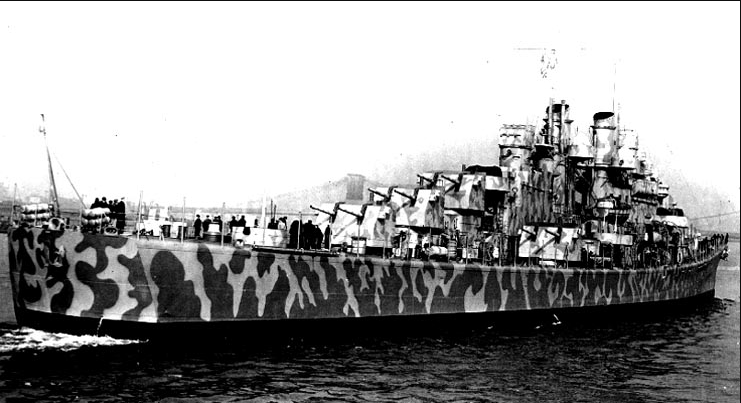
The light cruiser USS Juneau in New York Harbor in February 1942. The ship was sunk during the naval battle of Guadalcanal in the South Pacific in November 1942. Credit: U.S. Navy
After the war ended in 1945, the Bureau of Naval Personnel issued the following statement: “With the end of the war with Japan, the Navy can now revert to its long-time policy of not prohibiting members of the same family from serving together aboard the same ship or at the same activity.” This may not have had much impact, given that the Navy apparently never strictly enforced the prohibition on family members serving together even during the war.
In 1948, Congress passed the Selective Service Act that included a provision exempting the sole surviving son of a family if the family had one or more sons or daughters who had died as a result of military service. Later revisions have since expanded the exemption so that the current law provides a peacetime exemption for anyone–not just sole surviving sons–whose parent or sibling died, was captured, or is listed as missing in action as a result of military service. But nobody is exempt if Congress declares war or a national emergency.
Other Bands of Brothers
The sheer scale of the conflict and casualties in World War II meant that some American families suffered grievous losses even if family members deployed in geographically distant theaters far from each other. A notable example that inspired the 1998 film “Saving Private Ryan” came from the four Niland brothers who hailed from Tonawanda, New York. Each joined different Army units, but three of the four brothers participated in the D-Day invasion of Normandy, France on June 6, 1944.
Robert Niland, serving as a paratrooper in the 82nd Airborne Division, was killed while manning his machine gun behind enemy lines. Preston Niland, serving with the 4th Infantry Division, died near Omaha Beach during the huge Allied amphibious assault. Meanwhile, Edward Niland, the eldest brother, had already been reported as missing after his B-25 Mitchell bomber was shot down during a mission over Burma in May 1944. (Edward was later discovered to be alive after having survived imprisonment in a Japanese camp.)
When the U.S. Army discovered what had happened, it moved to exempt the surviving Niland brother from combat duty. Frederick “Fritz” Niland had been serving as a paratrooper with the 101st Airborne Division and had dropped between Omaha and Utah beaches during the D-Day invasion of France. But with his new orders, he was sent back to England and eventually the United States to serve as military police (MP) for the rest of the war.
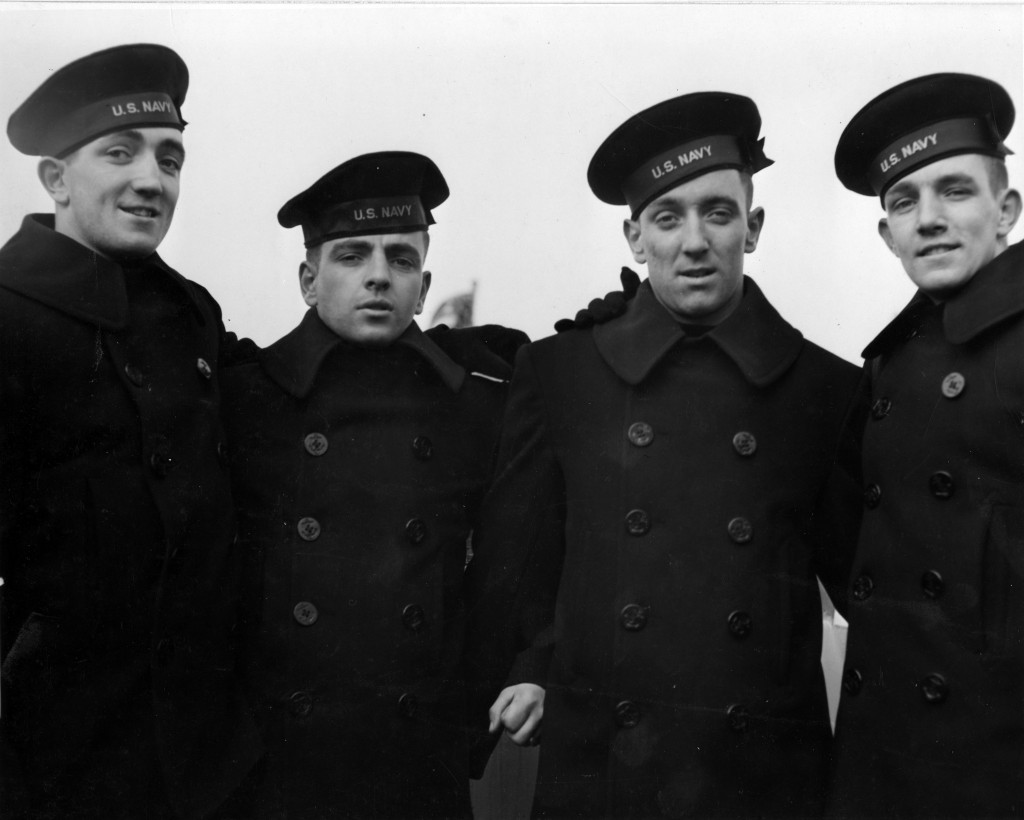
The four Rogers brothers at the commissioning ceremonies for the USS Juneau at the New York Navy Yard Feb. 14, 1942. They are Joseph, Patrick, Louis, and James. Left to right. Credit: U.S. Naval History and Heritage Command
Clearly, separation of family members serving in the military did not ensure that families would avoid losing multiple fathers, brothers and sons. But occasionally it did lead to different outcomes. The sinking of the USS Juneau could have meant a similar family tragedy involving the four Rogers brothers who were also serving together aboard the light cruiser, if not for two of the Rogers brothers making a fateful choice, according to the Naval History and Heritage Command.
Just weeks before the light cruiser was lost near Guadalcanal, two of the Rogers brothers decided to take the U.S. Navy up on an offer to separate brothers serving together. In October 1942, Joseph and James “Jimmy” Rogers decided to transfer from the USS Juneau to a supply ship. When the USS Juneau went down in November 1942, Patrick and Louie Rogers both died along with the Sullivans and most of the crew.
Joseph and Jimmy survived the war, and Joseph went on to marry and have a family. Both brothers eventually died as old men in the 1990s. That meant that neither lived to see Paul Allen’s expedition discover the wreckage from the USS Juneau lying on the seafloor near the Solomon Islands on March 17, 2018: 76 years after the light cruiser went down with the two Rogers brothers and five Sullivan brothers.
